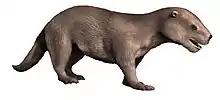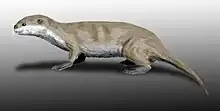Proneotherium
Proneotherium is an extinct genus of pinniped that lived approximately 20.43 to 15.97 mya[1] during the Early Miocene in what is now Oregon, U.S. It belonged to the family Odobenidae, the only extant species of which is the walrus.
| Proneotherium Temporal range: Early Miocene, | |
|---|---|
.png.webp) | |
| Scientific classification | |
| Domain: | Eukaryota |
| Kingdom: | Animalia |
| Phylum: | Chordata |
| Class: | Mammalia |
| Order: | Carnivora |
| Clade: | Pinnipedia |
| Family: | Odobenidae |
| Genus: | †Proneotherium Kohno et al., 1995 |
| Species: | †P. repenningi |
| Binomial name | |
| †Proneotherium repenningi Kohno et al., 1995 | |
Discovery
Four specimens of Proneotherium were discovered in the Astoria Formation of Lincoln County, Oregon, U.S. These specimens included cranial and postcranial remains and are all believed to be adult male animals.[2]
Description
Proneotherium were more similar in appearance to modern fur seals and sea lions than walruses. They lacked the long tusks of walruses, and were more slender and smaller than their modern relatives.
Autapomorphies of Proneotherium fossils include a continuous, horizontal crest connecting the mastoid and paroccipital processes of the skull. The teeth are also less secodont in function and appearance than more basal species.[2] This likely represents the slow shift from a piscivorous diet to the mollusk-based diet of modern walruses. The hindlimbs of Proneotherium also show the beginnings of evolutionary shifts from a terrestrial lifestyle to a more aquatic one.[2]
Taxonomy
Proneotherium represents some of the most basal members of Odobenidae. The sister group is the closely related Prototaria.
References
- "†Proneotherium Kohno et al. 1995 (walrus)". Fossilworks. Retrieved 17 December 2021.
- Deméré, T.A.; Berta, A. (1 July 2001). "A reevaluation of Proneotherium repenningi from the Miocene Astoria Formation of Oregon and its position as a basal odobenid (Pinnipedia: Mammalia)" (PDF). Journal of Vertebrate Paleontology. 21 (2): 279–310. doi:10.1671/0272-4634(2001)021[0279:AROPRF]2.0.CO;2 – via BioOne Complete.



